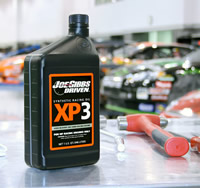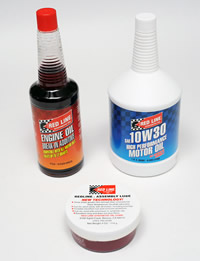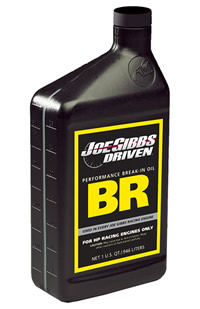Engine Oil Deep Dive - CAC's Comprehensive Look at Engine Oil and Flat-Tappet Camshaft Durability - Page 6 of 6
© 2009 by Hib Halverson
No use without permission, All Rights Reserved
![]() Discuss this article
Discuss this article
Assembly and Break-In
Take GF-4 oil and brown bag lifters out of the equation and a significant amount of cam/lifter failures blamed on oil were more likely caused by improper installation and break-in. Following the cam manufacturer's assembly/break-in instructions is imperative and we're going to expand on that.
If the cam's assembly lubricant is missing, don't even think about grease, gear lube or other "generic" substitute. Use Red Line Engine Assembly Lube on the cam, lifters and lifter bores in the block. It's a paste-type lubricant containing 2300 PPM phosphorous in a corrosion inhibiter gel which literally sticks to the cam and lifters until oil gets pumped to or splashed on the cam after the engine starts. The phos in the gel makes Red Line's Assembly Lube even better than molybdenumdisufilde-based products cam companies supply.
If your valvetrain uses single springs with open pressure greater than 325-pounds, use lower-pressure springs for break-in. If you're using a dual spring, only install the outers for break-in.
Use oil and a break-in supplement. It can be any of the additives discussed previously, but the we believe Red Line's Break-In Additive is good because 1) its 18,500 PPM phosphorous concentration lets you use half-a-bottle for break-in and the rest after the first oil change but still have an extremely high ZDP content and 2) of its ester base stock.
We suggest race engines with "big" flat-tappet cams be broken in on an engine dyno rather than in the car. Mix conventional oil with a supplement or use a dedicated break-in oil for racing engines, such as Joe Gibbs Driven "BR".
Prime the oiling system by driving the oil pump with a priming tool chucked into an electric drill. Do it until you see oil pressure on the gauge then keep doing it. Rotate the engine by hand several times during the process. Then, configure the your ignition, fuel and cooling systems such that the engine starts instantly and cools properly.
At the first two filter changes after cam installation, cut the old filter open and inspect the its media for metallic debris. You may find the filter trapped a lot of pre-lube, but if you find more than trace amounts of fine metallic "dust," tear down the engine to inspect the cam and lifters.
Use a break-in additive until the second oil change after installation, then switch to your regular engine oil.
Lastly, if you missed it the first time: follow the cam company's instructions for assembly and break-in. If you don't; count on a camshaft failure.
Blame Game
So...who's to blame for this fine mess we're in?
Big oil bears some responsibility. It could have done better informing the automotive enthusiast community about reduced ZDP and they could have brought specific solutions to market sooner.
The Federal Government is to blame because it started the ball rolling when it began to pressure the car companies to increase cat life. We need valvetrains to last 100,000 miles, not our cats to last 150,000.
Aftermarket cam companies contributed to the problem when their technology advances increased loads at the lobe/lifter interface, but the reputable ones did the right thing: advise customers about lessening ZDP content and the need for proper assembly/break-in. Too bad not everyone listened.
Some of the press has to take part of the blame for not being far enough out in front of this story to warn people, rather than reporting the aftermath.
Those who installed flat tappet cams, but ignored manufacturer recommendations as to installation, break-in and oil choice, get a substantial part of the blame.
Lastly, there are greedy vendors of crummy flat-tappets. Blame them, too.
Research for this oil deep dive was: interviews with engineers at oil companies, aftermarket cam manufacturers and General Motors Powertrain along with World Wide Web searches, information from oil refiners and the American Petroleum Institute (API) and, finally, three Society of Automotive Engineers (SAE) Technical Papers: Antiwear Performance of Low Phosphorous Engine Oils on Tappet Insets in Motored Sliding Valvetrain Test, (#2003-01-3119); How Much ZDP is Enough, (#2004-01-2986) and Development of the Sequence IIIG Engine Oil Certification Test (#2004-01-2987).
The Corvette Action Center, would like to thank the following for special assistance during the research for this article: Roy Howell, Vice President and Chief Engineer, Red Line Synthetic Oil Corporation; Chase Knight, Valve Train Products Manger, Crane Cams; Billy Godbold, Cam Design Research and Development Engineer, Comp Cams; Robert M. Olree, Fuels and Lubricants Manager, General Motors Powertrain and Chairman, Oil Committee, International Lubricant Standards and Approval Committee; Lake Speed Jr., Joe Gibbs Racing; Tim Wusz, Director of Engineering, Rockett Brand Racing Fuels and former petrochemical engineer for 76 Performance Products; Karen Ktardich, Media Relations Manager, Society of Automotive Engineers; Mark DeGroff, Mark DeGroff's Cylinder Head Service and Machine Shop; Graham Behan, Chief Engineer, Lingenfelter Performance Engineering and former LT5 Engine Release Engineer, Lotus Engineering; Barry Bronson, Valvoline Brand Specialist, Communications and Corporate Affairs Section, Ashland, Inc., Jim Van Dorn, General Manager, AutoMasters of Bowling Green, Inc.
Lastly, the CAC would like to thank Andy Bolig, Editor of Corvette Enthusist Magazine for his support. This article was based on a two-part series that published in CE's Jan. and Mar. 2009 issues and we appreciate Andy's help in bringing to the web.



